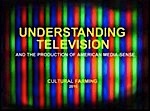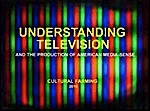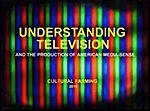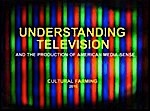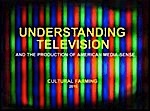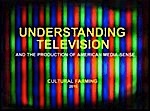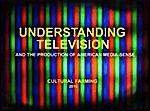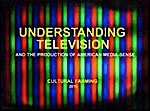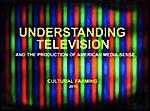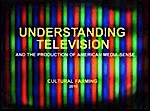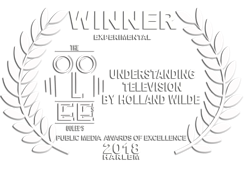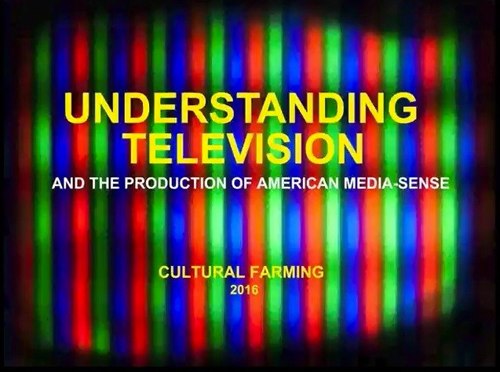(August 2017)
This website holds over 225 VIDEO PROJECTS -- each video is a unique experimental ethnographic video-essay. Most all projects were montaged between 2003-2017 under the (C)ritical method Cultural Farming. Collectively, these projects render an essential viewpoint of life with tele-visual media, which underlines how technological advance has incrementally manipulated simple human communication into something oddly inhuman, strangely evil, even murderously life-threatening. Merely re-rendering viewpoints, however, is the easy part. The true aim of this project is to proffer approaches and methods of resistance against the pseudo-validities of normative societal power structures.
In short, this project proffers a serious form of play, a technique which both reveals and challenges how many of our new-truths are machine-made. Indeed, our means and methods of mechanical media production -- along with the concrete practices of particular people -- are co-creating a ‘double-death’, speeding a new exterminating post-truth reality. This project is an illumination of this double-death. It is my media-viewpoint during this cusp of unimaginable technological change: We have produced our cameras and screens to be as lethal as guns and bullets.
Through sheer stupidity, we are failing Reality by failing to understand the lethality of our own graven media. We now find ourselves enslaved; sleepwalking inside a digital nightmare of mechanically doubled (sur)realities of lies, surveillance and war. We are about to face an intellectual and spiritual reckoning. Much human sacrifice will be required to appease this technological seizure. It will not be pretty. For while these warnings are regularly televised globally to anyone willing to watch, we humans remain unwilling to understand (link to most recent essay).

“Our unfortunate times thus compel me, once again, to write in a
new way. Some elements will be intentionally omitted; and the plan will
be to remain rather unclear. Readers will encounter certain decoys, like
the very hallmark of the era. As long as certain pages are interpolated
here and there, the overall meaning may appear: just as secret clauses
have very often been added to whatever treaties may openly stipulate,
just as some chemical agents only reveal their hidden properties when
they are combined with others. However, in this brief work there will be
only too many things which are, alas, easy to understand.”

What is going on here?
“We are dangerously failing at critical discernment throughout all informational media.”
Collectively, the projects herein perform a longitudinal depiction of how various North American media producers create their particular forms of tribal “common sense”. My video essays, however, do not attempt an explanation of this growing tribal reality, rather each project is an empirical recitation of our desires to mechanically produce one. It is how I see this new ‘feudalism’ (1,2) through my home TV and computer, which were my only two screens over the years while making these interminable 100+ hours of experimental ethnographic montage.
Many of these projects contain one individual video construction, some contain dozens, and a few projects hold thousands of individual videos. All projects are accessed by clicking any red, green and blue dot or bar on the Archives page. Inside these projects you will find a contextualized performance (a poesy) of the methods I utilize for (C)ritically understanding television.
As an exploratory form of social criticism, Understanding Television should be measured as a robust and ambitious ethnography of a great stretch of mediated history -- our history -- and what this looks like, why it’s here, and what lurks in the future. I do this in order to effectively journal these times: when cameras and guns and worldwide webs proliferate exponentially with quite similar complications. Indeed, Understanding Television reveals our culture dangerously wallowing in overwhelming ignorance, as we willfully ‘game’ the unfathomable predicaments of inescapable virulence, technological gods and human isolation.
“Let’s be clear. We humans are the ones who happily choose to wield lethal power over others.”
But let’s be clear. We humans are the ones who happily choose to wield lethal power over others with these easily weaponized technologies, whether it be television, artificial intelligence, Google, Facebook, Twitter, Snapchat, Instagram, et al. (NOTE: It takes very little effort to weaponize a weapon.) Humans of every stripe are now demanding to be ‘heard’ by any means necessary. Attempting to employ Cultural Farming requires the re-fusing of a culture’s apparatus of communication as a means for resisting the lethal rush of mechanical misunderstanding. This demands a massive societal undertaking. I see few signs of this happening today, yet the stakes are too high, and time is too short, to settle for anything less.
In this current-world where every living-subject is too easily turned to an image-object, our cameras, our guns and our webs are converging to detonate on a global scale, leading us into new kinds of carnage unforetold in the history of man. For as Kenneth Burke writes, “There is no difference, in photographic style, between the filming of a murder mystery and the filming of a documentary” (1950, p.17-18). But then again, maybe my entire fallacy is wrong.
How should viewers watch these video essays?
“I care less about what communication ‘says it says’ and more about how ‘what is said’ functions across society.”
In toto, these are experimental forms of ethnographic writing using only previously made media content. My intention is intellectual montage over artistic collage. I care less about what communication ‘says it says’ and more about how ‘what is said’ functions across society. I prefer sobriety over entertainment, ideological instability over conventional ways and means, nature and naturalism over reality and realism. I aim for healthy diversity through reforestations of understanding, which can help supplement the growing devaluation of liberal arts education.
Yet, each video project herein is designed as a ‘TV format’ expression. So sit close to the screen. I made these projects while sitting 27 inches away from a 27 inch computer screen. That ratio may be important. Also, the audio should be turned up to at least 7. And wear headphones; they help discern nuance. But ultimately, there are no rules for watching. Mine is a paratactic style of video writing, which reflects TV itself, and sharpens our focus upon the difficulties and contradictions of contemporary existence better than prevailing political discourse (Adorno). These are experimental video essays and each should be watched closely, re-read and studied with clear eyes like any other academic text. Just remember, the true potency of Cultural Farming lies inside doing, not watching.

“It can be regarded as a kind of symphony, or in another way as a
kind of opera -- or even a horse opera. It is not just music, a poem,
a song, a tragedy, a farce, and so forth. It is superficially profound,
entertaining and boring -- according to taste. It is a prophecy, a
political warning, a cryptogram, a preposterous movie and a writing
on the wall. It can even be regarded as a sort of machine: it works
too, believe me, as I have found out.”
Macolm Lowery, 1947

I do not favor technology, but technology often chooses us: Can’t see videos (.mp4 & .mov) on your screen? Try using another browser.

Introduction to the research.
If you question these opening statements, please consider a few examples. Have you ever attempted to photograph a natural vista or a close-up of a flower pedal only to come away frustrated because photographs never fully replicate the experience you were feeling right then? Has anyone ever snapped a quick pic of you against your wishes? Have you ever practiced photo-smiling in your bathroom mirror? Have you ever poked out the eyes of your mother in an old photograph?
“We have successfully conflated fact with fiction throughout every facet of human existence.”
Still unconvinced? Then I challenge you to slow-watch TV and closely count the massive number of quick-edits, or the number of impossible images and bizarre situations displayed on your screen. Talking animals? People flying? Dish soap turning into maple trees? Automobiles coursing through the arteries of your heart? Lifestyles of perverted perfection? Innumerable sur-realities like these can number into the hundreds per every 30 minutes. This is now the familiar, and through these ceaseless repetitions, we are forgetting how to see Real. We are successfully conflating fact with fiction throughout every facet of human existence.
However, in cases like these above, I wager a common response would be, “Well, that’s how good media is supposed to be made.” Or maybe you would decide to buy yourself better video equipment, to edit faster, to get your family to sit closer to lighting sources. You might even add some compelling music to enhance the viewing experience. (After all, audiences always love music videos best, right?) Well, these motivations, times a thousand, are but only some of the elementary ways media making compels us to knowingly lie to each other. We not only enjoy this, we now demand clever mechanical seduction throughout all story-telling, exactly as we consciously intend to seduce others.
But soon even ‘little white lies” eventually begin to add up to something consequential. These lies dangerously begin to blur very important human lines between reality and representation, between real and fake. Indeed, our representations of life have become our life. We not only allow this to happen, we encourage it.
Before we can gain understanding, however, we must be clearer in our terminology. The projects in this website are most concerned with common media production, rather than simply “the media”. The word “media” is always plural, referencing everything collectively: TV, camera, phone, computer, film, gaming, virtuality, social media, internet...including the telegraph, newspapers, magazines, smoke signals, electrical dots of light, and potentially a thousand other means of communication. Hence, there is no such one-thing called “THE-media”. It’s an ignorant usage of english language. And using this half-witted generalizing term signals little more than lazy babble. It is stupid-speaking, quite like today’s full retreat of the adverb. Using the term “the media” only further erodes clarity and dulls argument. This project, by comparison, is concerned with the broad range of TELE-visual forms of communication, which is exactly why making videos about this tele-visuality is more correct than most other academic writing styles. I use TV’s actual content -- in its own languages -- to tell its story.
“Just saying the dangerous phrase ‘the media’ creates impossible hurdles to understanding.”
Dangerously today we share a cultural ‘common sense’ too eager to collectively understand technological communication as Truth -- especially our own made media -- despite these glaring omissions. Even when media makers with their tools and techniques accurately convey factuality, which can be accomplished when the effort is made, our media remain a representational performance of some very narrow fact-field. Still we continue to irrationally believe and behave otherwise. Contemporary mechanical communication fails us so badly today we are finding it difficult to intelligently discuss this or any other topic.
These impossible hurdles not only obstruct Nature, they also promote a host of “fake” practices and beliefs. My argument, here in this research however, is diametrically different than the sorry cries of “fake news from THE-media” coming from legions of media illiterates purposefully blaming any viewpoint contradicting their own. Instead, I purposefully claim something different. I mistrust the apparatus first and foremost. For the apparatus begins at the very instant of thinking about “record”. And then afterward, after spiraling inside its own morass of “mechanical reproduction”, come all the historical foibles lurking inside of all human communication. It’s a certain recipe for disaster. So it should be no wonder then why informational communication is difficult and dangerous. The more we speak these broken languages, the faster disaster comes.
Few North Americans seem willing to finger THE-apparatus as a perpetrator. Consequentially, we humans remain slumped in post-diluvian-media ill-literacy, which is quickly bifurcating national intelligence. It takes critical practice to employ any machine wisely. And this experimental media site is my attempt to manifest a critical response to ‘common’ media production practices: The medium is a message’s biggest problem.
To be sure, certain approaches to media making are substantially more truth-telling than others. These approaches remain vital to human communication and understanding and can still, potentially, help lead to an ethical resumption of true documentary and journalism. But, the craftspeople of (capital-J) Journalism must double-vow to help ethically sharpen the tip of this protective spear of democracy. We all must learn to better acknowledge, control, and negate each medium’s falsity. I do not see this happening. In fact, the opposite is now hyper-fueled by ideological profiteers like Facebook and Sinclair Broadcasting. Until then, the first stance of media-consuming citizens should begin well beyond that of skepticism, and to lean more towards an attitude of educated cynicism.
Cynicism is characterized by a general wariness of self-interested motives. Cynics hold healthy skepticism of faith or hope in human activity; particularly when these activities are motivated by ambition, desire, greed, materialism, self-aggrandizement, or goals and opinions. A cynic perceives these motivations as omissive, futile, vain or ultimately meaningless; and thus deserving of dismissal, ridicule or admonishment. Educated cynicism is how current lies of a ‘fair and balanced’ news media -- and even a President -- can be exposed, countered and neutralized. This kind of critical re-functioning is not easy, but it can be accomplished personally and privately at home using an independent intellect.
Media cynicism is fundamentally important to understanding television. A cynical media education instills a constant reminder of the imperfectness residing inside all human communication since time immemorial. Indeed, clear, honest and truthful communication is, to say the least, an enormous human challenge demanding constant effort and precision. Educated media cynicism is also an intellectual check-and-balance while accepting technology’s unending advance. (The methods used throughout this site include ‘genetic’ archiving, remix and iconoclasm.) We must remember that the tools and techniques inside each medium mechanically edit, accelerate, obfuscate, contradict, shift, mute and/or amplify a message’s original intention. These mechanics collude inside the apparatus itself to hinder factuality, all while simultaneously promoting itself and countless other dubious agendas. So-called ‘content’ is last in order of importance.
“Each new form of communication requires equally new investigations into its language, rhetoric, grammar and logic.”
Lying, both human and mechanical, is so commonplace, we are reflexively refusing to accept the logics of factual information. Lies in unending repetition quickly build dangerous alternative truths, which undermine our understanding of how we humans have historically understood the differences between truth and ‘truthiness’. Inside this human-made swirl of absurdity, we find that blaming Hillary Clinton for causing four deaths in Benghazi becomes an equivalent to Colgate’s promise of the best-tasting toothpaste. Both claims of truth may include bits of factuality, but they are overwhelmingly omissive, thus false.
Moreover, regardless of medium, simply repeating falsehoods is apparently enough to make them Truth. The people and processes pushing this exploitation must be called out, questioned and held responsible at every turn. And all this needs to happen during each step of media making: What we say, why we say it, the way we say it, and what we use to get it said. This is a tall order holding enormous consequence for any ill-educated society which continues to champion job creation over civic humanities education.
This website seeks to collate and unveil some of the lies and fallibilities inherent throughout historical media making, and the convenient reasons why we continually rush to favor these false experiences. I do not suppose Truth here in my video essays, rather I itemize and illustrate a host of media fallacies, which I have witnessed for myself right in my home since 2003. This research concludes: If you believe contemporary media production, you need a better belief system. Better still, triple-test all your beliefs against actual human experience, which is my desperate call: Step away from your screen-beliefs and go out into Nature to gain more fulsome human experience. Cynicism is but the first step to understanding, especially when it comes to media like television. We must never sacrifice Truth to just our eyes and ears.
What does understanding television mean?
To aid my own understanding, over the last 14 years I have accumulated and contrasted much of this historical televisual change. My aggregations trace the primary premise of contemporary media making: to perfectly hypnotize ourselves and others, like frogs floating in pots of slow-boiling water, until we are perfectly cooked. And then in return, agreeably under its influence, we perfectly respond by demanding even more heat. This hegemonic perversity should not be an overriding premise of any communicational medium. But it is.
“We believe we understand media and media making, but we are ill-trained ... amateurs, professionals and academicians alike.”
We believe we understand media and media making, but we are ill-trained -- amateurs, professionals and academicians alike. We now find little reason to think about communication before we act. Because of this we have rapidly transitioned, in just one human generation, from passive mass-spectating to complete and voluntary individualized media immersion. This comes with great risk to both the idea and practice of historical human communication.
I have, over the course of this project, critiqued thorny Tower of Babel talk like “We are the media!” (Even in its newest rendition: Je suis Charlie.) I would counter expressions like these with my own, “We are not media, rather we are humans on Earth who communicate badly with many forms of media machines.” But today, I am not so sure. Maybe we are becoming our media. At the very least, we eagerly encourage media-makers to make us into their media images. And this mechanical mystification is where most of my Cultural Farming projects come into surreal focus.
Best-practice farmers understand that growing good soil comes well before growing good plants. And this is the challenge of Cultural Farming: to longitudinally compare, recontextualize, diversify, cultivate and harvest healthier media, which naturally requires heavy-lifting, tilling, planting, mulching, weeding, pruning, fertilizing. Like any farmland, we need to work our mediascapes toward simpler and healthier production, and further away from genetic (technological) modification. Why do this? Because Form reforms Function exactly as Accuracy reforms Truth. This, intellectually, is a much different premise than re-mix parody, or snapping smart-phone-selfies, or dumping video into YouTube, or grunting for celebrity in 140 characters, or even gaming the craft of Journalism for profit -- and it is radically different from much of so-called ‘documentary’. For these mostly unreflexive methods foster little more than toxic vast wastelands.
“When artifice becomes natural no amount of description adds up to depiction.”
I do so by refracting historical televisual practices through the colored lenses of Critical Theory using ethnographically surreal methodologies. My purpose here is to edit against the grain of too-familiar TV practice, and towards a higher form of media memory, understanding and response: reciprocal verisimilitude. This is the true “work of art” in the age of its mechanical reproducibility: to identify and recover sacred boundaries. For when artifice becomes Nature, no amount of description adds up to depiction.
Thinking is not a performing art...it is why we need an Art for Thinking.
Cultural Farming is wholly designed for personal intellectual profit. And I do it all without ever touching a camera; in part because one of the very first lessons gleaned from applying Cultural Farming to media understanding is that pushing-a-button today is too often the same as pulling-a-trigger. I mean this literally, not as metaphor. Hence, in reply, I employ TV against itself through forms of symbolic exchange by critically collecting, reciting and contrasting the languages and techniques of contemporary communication in order to return its gifts. This reciprocation is a necessary, sacred and liberating form of media potlatch.
We assume technology will solve every conceivable human want, and beyond. But today’s technological weaponization of communication holds dire consequences for every living thing on our planet. This new pornography, which can be likened to a righteous mechanical form of theocratic dominionism, is the false promise of a poisonous new fidelity mutually designed by the lords and vassals of these new communicating machines (read: Google, Apple, Microsoft, Facebook, Twitter, Snapchat, Instagram, Amazon, Netflix, et al). It heralds a violent informational Dark Age of more dead metaphors, false equivalency, flaccid journalism and mechanical sadism across the so-called Seven Mountains of Culture: media, government, religion, family, business, education, and arts and entertainment. Beating plowshares into swords, however, must be rebuked with equal force. Cultural Farming can help to repay.
“Beating plowshares into swords, however, must be rebuked with equal force.”
Technological lethality pervades two ways. First, by converting any subject into object. Second, through its binary alienation -- self/other, near/far, local/foreign. Both help stoke growing tribal outrage over social beliefs. Hence, humans living in a mediated world need critical methods for fulsome response. Citizens need sharper methods for replying to today’s growing one-way interpellations. We must craft these replies clearly and immediately, even when critical comparison demands an equal shaming usage of the very same ‘doublespeak’ grammars (Orwellian Newspeak) mediamongers so perversely master.
How do I understand television?
“I never found any trace of an independent or liberal media anywhere inside the television industry.”
To help foreground my unique approach to understanding television, all my videos are made in the comfort and privacy of my own home while watching a 15” TV screen. Most every day, when I am not outdoors planting trees, I simultaneously watch four major U.S. 24hour news channels: CNN, FOX News, MSNBC, and CNBC.
I also typically watch a range of live TV events: daily news & talk shows, elections, celebrations, sports, etc., for these are where we typically find informational media production on display in its primary forms. I also collect a wide variety of historical examples of media making. These range from individual artistic expressions to exemplars of common media memory. Daily, to augment these limited informational media sources, I also learn elsewhere: CSPAN, PBS, NPR, NYT, WSJ, WaPo, IBD, The Guardian, The Globe and Mail, among others. I also read philosophy, often Thoreau, in bed. This sketches my daily media bubble.
What I do not watch is the other 90% of TV’s content, which is purposefully fictional and/or anti-informational. I almost never go to the cinema. I very rarely access YouTube. I do not own a cell phone. I have never Facebook’ed, texted, swiped, played a video game, interacted with touch-screens or donned a VR headset. I own no apps. Nor do I subscribe to NetFlix, Hulu, HBO or any of a host of other televisual venues available to North American consumers. I do not read Reddit, Politico, The Onion, Huffington Post, Boing Boing, Mashable, The Drudge Report, Breitbart News. I leave research into these media sources to other more ambitious ethnographers. There are only so many hours in my day.
“My projects, therefore, should be viewed as critical educational methods for self-training -- autodidactic praxis.”
All content within this site was montaged by me alone, although much of it, obviously, was previously ‘produced’ by many-many others...mostly anonymous mediamongers. The only two digital tools I use are, by today’s app-happy standards, so simple they are reminisced much like paper and pencil: iMovie-6 software (2006) and an iMac computer (2009). Content here is collected and presented neither as ‘fine art’ or as ‘bloopers’ -- nor as a trap for the gaze -- but as ethnographic exemplars of the consequences inside historical communicational technique.
I do this purposefully, since Media and Art can no longer stand under any democratic or revolutionary law of strategy; although the “work of art” can (potentially) be redeemed for countering reification: Art for Thinking. My projects, therefore, should be viewed as critical educational methods for self-training -- autodidactic praxis -- which should be robustly employed inside all media pedagogy. (For example, Cultural Farming can be a useful method to intellectually assay the “truthiness” of Quenton Tarantino’s (sic) “vermisitude”.) Indeed, when the viable notion of Carnivalesque today is worse than stupidly produced, critical polyphonic methods like Cultural Farming often reveal that Thinking Art can sometimes be more productive than ‘truth’ itself... without the use of narcotics.
What does using theory mean?
“Contrary to prevalent mis-definitions, surrealism is not an aesthetic doctrine, nor a philosophical system, nor a mere literary or artistic school. It is an unrelenting revolt against a civilization that
reduces all human aspirations to market values,
religious impostures, universal boredoms and
misery. Specialists in revolt: the surrealists thus described
themselves in an early tract. Born of the appalling conflict between the
inexhaustible powers of the mind and the impoverished conditions of
everyday life, surrealism aims at nothing less than complete human
emancipation, the reconstruction of society governed by the watchword
To each according to his desire.
“More specifically, surrealism aims to reduce, and ultimately to
resolve, the contradictions between sleeping and waking, dreams and
action, reason and madness, the conscious and the unconscious, the
individual and society, the subjective and the objective. It aims to free
the imagination from the mechanisms of psychic and social repression,
so that the inspiration and exaltation heretofore regarded as the
exclusive domain of poets and artists will be acknowledged as the
common property of all” (Rosemont, 1978, p.1).

Media Theory, of course, means different things to different people, for instance between the Institute of Social Research and the Internet Research Agency. Importantly, refracting within the undulations of surrealism, each project herein should be viewed through particular theoretical filters, for instance, as “Epic Smoker’s Theatre”. This is how Bertolt Brecht (1898-1956), arguably our most provocative modern poet-playwright, intended his Epic works to be consumed. He wanted his audiences to watch intellectually not emotionally; to lean back disengaged, not forwards immersed in empathy. He suggested smoking cigarettes and watching each production dispassionately...with critical distance. Brecht held disdain for theatrical machinations that emotionally trick audiences into intellectual passivity. His theatre developed a variety of (critical theory) techniques for countering pathos and immersion...and fascism. Brecht’s radical dramaturgy deeply informs Cultural Farming’s theory and practice.
“The proof of the pudding is in the eating.
Sergei Eisenstein (1898-1948), perhaps the most influential early soviet filmmaker, perfected a parallel theoretical filmic technique: Montage...the mother of all media special effects. Eisenstein’s methods attempted to write a kind of explosive short-hand, through “intellectual collisions” of images and ideas. He edited his film clips intending each to explode, allowing for alternative unspoken concepts to arise in the aftermath. Eisenstein’s works are masterpieces of between-the-lines visual expression. He was the first to assert a camera-machine as mightily as the sword. He soon realized, however, just how politically charged and personally dangerous his theory and practice would prove to be. For the catastrophe of critical provocation is that the utterer is commonly its first casualty, as Cultural Farming can also attest.
“It is not a Kino-Eye we need, but a Kino-Fist.”
Likewise, Walter Benjamin (1892-1940), Germany’s most cited media theorist, wanted to construct an allegorical ‘quotational arcade’ for tracing Europe’s calamitous turn to Modernity. He called his Arcades Project “rag-pickings” because he intended it to be collaged from trifling, yet exemplary, bits of cultural detritus. Benjamin deeply understood he could only illuminate his ‘profane panorama’ through the usage of surrealistic methods -- quite like Brecht and Eisenstein -- in order to properly explicate a new reality shocked between two world wars edging to the doorstep of history’s most hideous mechanical absurdities. Today however, we find surrealism to be but one more intellectual concept, so utterly hijacked and corrupted, we have entirely lost its true essence. True Surrealism is a suite of robust methodological techniques, which Cultural Farming attempts to recover, precisely because it conjures Benjamin’s illusive intersection of positivism and mysticism.
Arcades Project: “This work has to develop to the highest degree the art of citing without quotation marks. Its theory is intimately related to that of montage.”
Marshall McLuhan (1911-1980), media theory’s meteoric and misunderstood celebrity-philosopher, also deeply played inside communication’s plasticity. To McLuhan, language was mankind’s first technology. He purposefully tricked with words, as we so carelessly do today with electric media, to confound towards multiple modes of comprehension. He reveled in outing alternate currencies of meanings parodied inside liturgical ignorance and the mechanics of clumsy syntax. McLuhan’s specter was James Joyce, by necessity, for McLuhan understood Joycean polysemy helps to ground fulsome intellectual sense. Grammar-logic-rhetoric; turn on-tune in-drop out; give-receive-reciprocate...each a critical mantra pulsing throughout Cultural Farming.
“We shape our tools, and thereafter our tools shape us.”
Yet as the infamous post-modern philosopher, Jean Baudrillard (1929-2007), explained: There is no liberation or revolution of the media available to us, except for "restoring the possibility of response". For Baudrillard, we must allow media-speech to "be able to exchange, give back and repay itself" through forms of Symbolic Exchange (potlatch). Ironically, Baurdillard admits this would require "an upheaval in the entire existing structure of media". Unfortunately, unlike McLuhan, Baudrillard never gets around to offering us a useful critical praxis. Understanding Television, however, may well express viable strategies for waging ‘necessary personal revolution’. Yet we willfully promote a dependency upon tyrannical media (obscene & panoptic), which seduce with an ecstasy of appearance through ever higher resolution lenses and screens. For when “vision machines” (Virilio) rule by means of paradoxical logic, surveillance and punishment go hand-in-hand inside the simulacrum of hyperreality (Foucualt).
"More real than real, that is how the real is abolished."
And as for the methodological haunts of SURREALISM residing inside every Cultural Farming video, I defer to Michael Löwy, (2012):
“It is impossible to imagine an activity more contrary to these times,
and less opportune, than that of a Surrealist Group at the beginning of the
21st century.
Surrealism must not be confused with the so-called "artistic avant-
gardes" that succeed one another after flourishing for a short period -- such
as Fauvism, Cubism, Expressionism, Futurism, Dadaism, Abstract
Expressionism, Pop Art and others. Surrealism is simultaneously artistic,
philosophical and political, as were the Baroque and Romantic movements.
Like alchemy, socialism and the Romantic philosophy of nature,
Surrealism is a matter of tradition. It has an ensemble of writings,
manifestoes, and documents that transmit its esoteric, philosophical and
political message, as well as a continuity of magical and poetic practices.
It refuses to erase the past. Anything that cannot find a spark of hope in
the past has no future.
But Surrealism like hermeticism, sorcery, piracy and utopia, is above all
a matter of creative imagination. Like the cangaceiros, the noble bandits
of the Brazilian woods, the Surrealists are doomed to innovate, invent and
explore. The old ways, paved roads, and beaten paths are in the hands of
the enemy. New ways must be found --- the wanderer makes the path.”
What is the video at top of this page about?
I care little about entertaining an audience (or even cultivating an audience). I care even less about proselytizing more ideological pablum. Instead, I insist upon interrupting and antagonizing normative, passive, media production and immersion, by allowing critical spaces for myself and for viewers to consider their own thinking processes while watching these fillips collide. Moreover, each video is an experiential writing form -- ethnographic surrealism -- hand-fashioned into my theoretical aesthetic (ekphrasis) for unveiling our mediating worlds.
“Unlike Aristotelian tragedy, imitation is no longer the goal, since that affords the ‘space of seduction’ between spectator and spectacle.”
I confound the double bind of mimesis by mixing methods of Artaud's theater of cruelty -- a “half-way point between thought and gesture.” This for Cultural Farming vexes the gap between the closed worlds of media making and media consumption, by attempting to provoke critical (dialectic/dialogic/didactic) modes of understanding. And I do this because TV is no longer ‘looked at’ with any concentrated attention, rather it is perceived, as Walter Benjamin noted, in a state of (mechanical) distraction. If nothing else, Cultural Farming provides a critical practice for ‘waking up’. As Douglas Kellner (2001) writes:
“...a television studies that is critical and multicultural provides
comprehensive approaches to culture that can be applied to a wide
variety of artifacts -- from a TV series to phenomena like Madonna, from
MTV to TV news, or to specific events like the 2000 U.S. presidential
election, or media representations of the 2001 terrorist attacks on the
U.S. and the U.S. response.
“Its comprehensive perspectives encompass political economy, textual
analysis, and audience research and provide critical and political
perspectives that enable individuals to dissect the meanings, messages,
and effects of dominant cultural forms. A critical television and cultural
studies is thus part of a media pedagogy that enables individuals to
resist media manipulation and to increase their freedom and
individuality. It can empower people to gain sovereignty over their
culture and to be able to struggle for alternative cultures and political
change. Cultural studies is thus not just another academic fad, but can
be part of a struggle for a better society and a better life.”
Here, my project topics vary with numerous televisual currents (convolutes) running throughout: Potlatch, image making, cameras-screens-guns, media history & technology, communication & journalism, poetry & jazz. Any video may also loop a host of sub-themes like: telephones, politics, gaming, consumption, fashion, fear & death, business, feminism, education, religion, children, medicine, human bodies, language, celebrity, food production, pornography, robots & drones, military & war, surveillance & privacy, race & gender, nature & animals, virtual & live events... Nevertheless, every video illustrates particular amplified intentions (ethics) inherently resident inside the ‘production of production’ of media, which conflate a collective media ‘common sense’.
Many videos here share similar technics. But there are differences. For instance, this particular video at the top of the page , LINKED HERE AGAIN, is a bit unusual in that it is split equally into halves. The first portion is content ripped entirely from just one hour-long History Channel program. I discarded most of its pathetic futurist excrement, but aggregated the amplified visuals I wanted to re-function. I then inserted non-diegetic contrapuntal audio accompaniment, which I happened to hear on TV just the night before. This orchestral music is from a feature film entitled Another Earth and composed by Fall On Your Sword. I appropriated this music primarily because it provided an excellent scaffold for me to edit around, and it was approximately the same length as the content gathered.
“This is Surrealism and Fair Use put to good work. It is Cynicism well spoken, and ‘magical aura’ reconsidered.”
During exercises like these, I posit that one quickly begins to understand media’s very dangerous potential to reshape anything to suit any particular need. However, mine is also a new story, equally as ‘true’ as the original. Therein lies the magical lethality continuously being remade and relearned, yet which mostly escapes science and technology. For this is Surrealism and Fair Use put to good work. It is Cynicism well spoken, and “magical aura” reconsidered. It is a triangulation towards truth. It is wisdom gained through a praxis of contradiction: negative dialectics.
“I want you so bad, it’s driving me mad, its driving me mad.”
The second half of this same video is more difficult. It centers around the recent Paris/ISIS terrorist massacre (13Nov15). I made this video as it simultaneously spilled into my home as LIVE TV -- while network employees wittingly amplified real fear and confusion with non-sensical TV production methods believed to be most palatable for consumption. This portion of my video is not meant to shock, rather it should elicit shame -- shame for how we so eagerly produce and devour ever increasing horror as spectacular entertainment under the guise of news & information. It outlines the utter lack of ethical purpose now continuously produced throughout too much of televisual journalism.
Unfortunately, I have previously recorded many similar events (1, 2, 3). And with each daily death-event, standard TV production simply goes into round-the-clock stasis. Shock and anecdote are championed over factuality. Repetition cancels cognition. We eagerly ingest another media spectacle with mouths agape, awaiting the next dosage of magic bullets from very real hypodermic algorithms openly administered by a very real and growing Surveillance State. Nothing could be worse, right? Wait...how about we all attach our cameras to miniature helicopters! Neat...another new form of gun...or is this an opioid? Good question.
“We eagerly ingest another media spectacle with mouths agape, awaiting the next dosage of magic bullets from very real hypodermic algorithms.”
“She’s so heavy.” ...but how do “she” and “heavy” mean?
Critical insight from each of my editing choices truly begins to occur during the act of re-production, in the case here, by slowing down both music and image to an other-worldly speed. We know this music very well, only now it is oddly different, conjuring fresh connectivities. This is only one simple but effective technique for making strange (Verfremdungseffekt). While there are hundreds of individual edits in this 30minute video, all are attempts to elicit a new transparency, a truer personal memory. Because we now too often willfully exclaim, “It was surreal... just like a movie!”, and happily turn away to another media channel, further conflating actual with its mediated appearance.
What was discovered in this research?
“Everything for the people. Nothing by the people.”
An unchallenged communicational “bully pulpit” does not happen accidentally. Whether ISIS, YouTuber’s or General Motors, media makers equally profit from similar technological façades of communication, each boasting grand victories of media seduction and radicalization through mechanical ‘common-sense’ techniques of coercion and consent. It is why the entire ‘super class’ (from Angela Merkel to Jon Stewart to Ivanka Trump to Joel Osteen to Kate Middleton to Bashar al-Assad to Tom Brady) now always speak to camera in exactly the same manner. It is how Hate literally communicates its mob psychology in order to trump Love. In the propagandist writings of Edward Bernays (1928), we read:
“In theory, every citizen makes up his mind on public questions and matters of
private conduct. In practice, if all men had to study for themselves the abstruse
economic, political, and ethical data involved in every question, they would find
it impossible to come to a conclusion about anything. We have voluntarily
agreed to let an invisible government sift the data and high-spot the outstanding
issues so that our field of choice shall be narrowed to practical proportions...
“So vast are the numbers of minds which can be regimented, and so
tenacious are they when regimented, that a group at times offers an irresistible
pressure before which legislators, editors, and teachers are helpless. The
group will cling to its stereotype, as Walter Lippmann calls it, making of those
supposedly powerful beings, the leaders of public opinion, mere bits of driftwood
in the surf.
“When an Imperial Wizard, sensing what is perhaps hunger for an ideal, offers
a picture of a nation all Nordic and nationalistic, the common man of the old
American stock, feeling himself elbowed out of his rightful position and
prosperity by the newer immigrant stocks, grasps the picture which fits in so
neatly with his prejudices, and makes it his own. He buys the sheet and pillow-
case costume, and bands with his fellows by the thousand into a huge group
powerful enough to swing state elections and to throw a ponderous monkey
wrench into a national convention.”
Media seduction and radicalization through mechanical ‘common-sense’ techniques of coercion and consent is how entire populations can be hoodwinked to happily act against their own best interests. It is how the U.S turned to war against Iraq in 2003 without evidence of weapons of mass-destruction. It is how John Kerry was “swiftboated” in 2004. It is how Barak Obama got born in Kenya in 2008. It is how Apple overtook Microsoft in 2010, and why FOX News never acknowledges that it is part of “THE-media”. It is how ‘media strongmen’ Steve Bannon and Roger Ailes gaslight fiction into fact in 2016. Indeed, brutal repetition works, but chickens like these always come home to roost.
“This signals a cataclysmic shifting of power, since there can no longer be any claim to Truth, and therefore no claim to the ‘right side’ of history.”
At face value, Understanding Television clearly illustrates that the primary purpose of contemporary media production really is to hypnotize: to simultaneously bait and beat (entertain and seduce) every viewer into agreeable submission. That shouldn’t surprise anyone. Just under this surface, however, you will soon begin to understand that wielding lethal forms of power against others is apparently at least half the joy of being human (or an image) in this world. Maybe this is why we so cheerfully claim addiction to our media: “We are the media!” instead of “Sapere aude.” Or maybe it is because too many 21st Century media philosophes secretly desire their own monarchies as much as their rulers. Regardless of your answer, when major mouthpieces of informational communication get hijacked, Democracy gets decapitated, and only the strongest get to survive. This encourages a full embrace of the primitive world of “the killer”. After all, killing is infinitely easier, quicker and more decisive than thinking. We forget, however, that speed kills too.
“Tomorrow belongs...Tomorrow belongs to me.”
Cultural Farming is the only means I know to privately help inoculate oneself from this communicational spiral and reclaim human communication through equal acts of immediate critical response. There is still time to refuse, at least until every corner of our human brains have been perfectly mapped and plumbed for profit. It is why I re-employ actual TV production to illuminate, rather than to vacuously interpret with still more cameras and words.
Cultural Farming reveals that the devil residing in communication expresses itself equally inside our tools and practices. And once you understand this for yourself, you may actually begin to feel dirty adding to the pestilence by making media in these same old “bully” ways. And then, you may even begin to regret your own deep dependency on technological communication. Who knows? From time-to-time, you might even feel courageous and choose to celebrate the natural world by opting away from mendacious technological production in order to engage the craft of communicating in more healthy human ways. That is unless you too are simply another killer by nature, which of course humans naturally are. And this glib fact poses a deep political and philosophical dilemma. For the dirty little secret of human existence is that those refusing to be killers are usually among the first to be eaten. Indeed, Enlightenment must always grapple with the laws of cold hard nature. Cultural famers understand this is a constant clarion call.
What if viewers still don’t ‘understand’ television?
Still, after a lifetime of watching, making and studying television, I have found no better approach than Cultural Farming for truly understanding televisual communication -- even though I wager that the ‘crimes of the camera’, which I am attempting to elicit, will escape most viewers to this website, exactly as viewers will continue to prioritize story and content over its production. And so, whatever claims made or not made in these projects continue to seek confirmation.
“When communication is mechanically made primarily one way, only very few things can ever be said.”
We should always be asking, “Why am I spoken to in this manner? Who is holding this camera, pushing this button, and selling this to me...and why do I keep buying into it all?” Because the purpose of writing and watching critically surreal media ethnography is to consider what is gained and lost through typical, common-sense, communication production practices. Always ask yourself: “Isn’t this all just the same old shit?” Because, of course, it is; over 100 hours of the “same ‘ol shit”. For when communication is primarily made one mechanical way, only very few things can ever be communicated. Indeed, all videos here professes the same mechanical pablum. This project is about how humans shouldn’t communicate.
Persistent cultural inertia luxuriates here, betwixt and between identical drumbeats duplicating inside these addicting technologies. Every mechanical medium is but a false communication via deprivation chamber: Hyper simulation and Ecstasy of communication. However, once we begin to employ critical filters and methods, we soon begin to awaken and discover we are more than willing attendees to this spectacle of our own obliteration into appearance. And we begin to understand that our beloved -- necessary -- technologies too often trick away our humanness through endless pornographic promises of certitude, power, pleasure and immortality.
“Argue as much as you will, and about what you will, only obey!”
Every project herein illustrates the profound folly inherent in contemporary media practice and interpretation. And so, each of my videos is fashioned to encourage myself and viewers to slow down and see and think anew, comparatively, through new insights in new ways. Hopefully, this might inspire other acts of personal emancipation from hegemonic media domination and consent. After all, the point of (C)ritical investigation -- and the work of Cultural Farming -- is radical translation over indefeasible interpretation. At bottom, as if there could ever be a bottom, my video essays are comparative sketches rendered as tools for sharpening our focus when understanding contemporary televisual communication.
“Production is essentially all we CAN say with media anyway.”
My video ‘prestations’ illuminate common technological communication practices. They reveal that the ‘manner’ in which we communicate always precedes -- and too often supersedes -- whatever it is we intend to say. This alone must position media production as a ‘primary cultural actor’. And increasingly today, as my videos document: Production is essentially all we CAN say with media anyway. Indeed, the medium’s mystical message lies inside the video witch-doctor’s massage.

“To fall out of step with one’s tribe; to step beyond one’s tribe into a world
that is larger mentally but smaller numerically – if alienation or dissidence is
not your habitual or gratifying posture, this is a complex, difficult process.
It is hard to defy the wisdom of the tribe, the wisdom that values the lives of
members of the tribe above all others. It will always be unpopular – it will
always be deemed unpatriotic – to say that the lives of the members of the
other tribe are as valuable as one’s own. It is easier to give one’s allegiance
to those we know, to those we see, to those with whom we are embedded,
to those with whom we share – as we may – a community of fear.”
Ok, now what’s the next step?
And so, to truly understand media like television, you’ll need to reap these benefits for yourself by responding to (smashing) your own mediascapes... because the genuine purpose of Cultural Farming is personal emancipation, which can truly occur during critical experimentation. Just understand that being a cultural farmer is difficult because it is good honest hard work. For the price of true personal liberation is time, practice, theory and luck. So stop hypocritically idolizing and begin a true secular understanding of media.
15 The idols of the heathen are silver and gold, the work of men's hands.
16 They have mouths, but they speak not; eyes have they, but they see not;
17 They have ears, but they hear not; neither is there any breath in their mouths.
18 They that make them are like unto them: so is every one that trusteth in them.
If all else fails, no worries, choose a parallel path...go plant a tree. That is what I am doing now...after the Orgy. And I reflect fondly upon that dusty melodic aphorism from Timothy Leary (1920-1996): “Virtual reality is electronic acid”. Indeed, Google, Facebook, YouTube, Twitter, et al, are now actual fully-loaded semi-automatic killing machines today. Cultivate your TV understanding!
Thinking is not a performing art...it is why we need an Art for Thinking.
An American
resident of Canada, experimenting with new forms of critical media ethnography in Cultural Farming
